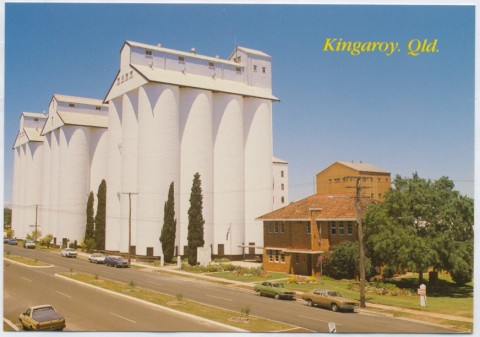Kingaroy, a rural town, is 115 km west of Nambour and 160 km north-west of central Brisbane. It is thought that the name was derived from an Aboriginal word describing a small black ant or a red ant.
The Kingaroy area was first occupied as the Burrandowan pastoral run (1843) by Henry Stuart Russell. The Burrandowan homestead was about 50 km west of Kingaroy. Closer to the township was the Taabinga pastoral run (1846). Both the Burrandowan and Taabinga homesteads (1849-50s) are listed on the Queensland heritage register. Following the resumption of part of both pastoral runs, an area of 21 sq km known as the Kingaroy Paddock selection was formed, and a corner post of the paddock stood where the township was established. Its establishment was coincidental, being the 56 mile peg where a stage of the railway extension from Kilkivan was planned to end in 1904. In anticipation, there was a small settlement with a hotel, store and school, but within three years of the creation of the rail terminus Kingaroy had four hotels, a butter factory and an agricultural, pastoral and industrial society (1905). The railway terminus at Kingaroy continued until 1911, when the line was extended to Nanango.
During 1908-10 Methodist, Anglican, Presbyterian and Catholic churches were opened. The Lutheran church at Edenvale continued to serve the district, ministered to by Pastor G. Bjelke-Petersen, father of the future Premier of Queensland. The Kingaroy Lutheran church was opened in 1936.
By 1907 most of the Taabinga pastoral estate had been resumed for closer-settlement. Sawmillers had a ready supply of timber as the area was cleared, and exotic pastures were planted for the dairy industry. Peanut farming also started, becoming a mainstay of Kingaroy crops, along with lentils and navy beans.
In 1910 a school of arts was opened, and a State high school in 1918. A hospital followed in 1919, and in 1924 an electric power station began operation. The first of Kingaroy's giant peanut silos was built in 1928. Earlier, in 1912, Kingaroy Shire had been proclaimed. The town comprised about one-quarter of the Shire's population. By 1947 it had risen to one-half, and by 2001 it was two-thirds. The 1950s saw the addition of a new swimming pool (1953) in Kingaroy, together with augmented town-water supply and a sewerage scheme.
During the postwar years all censuses but one (1971) have recorded a population increase for both the Shire and the town. Kingaroy has become a regional centre with churches for numerous faiths, notably Lutheran, with its own primary school (1989). Educationally, there are also a TAFE (1986), two State primary schools (1902, 1969), the South Burnett Catholic College (P-12) and a State high school. There are elderly persons' facilities, a large general hospital, numerous motels and hotels, an extensive group of sports facilities adjacent to the showground, a drive-in Shoppingworld (1984) and a large group of grain/peanut silos next to the railway line. A heritage museum and tourist centre are overlooked by the silos. The Kingaroy council offices are the headquarters of the South Burnett Regional Council (2008).
The decline of dairying in the South Burnett district during the 1960s led to the closure of dairy factories in smaller centres, and Kingaroy's turn came in 1977. From a peak production of nearly 100 tons of butter a week in 1929-30, the Kingaroy factory processed just one and a half tons before it closed. By then, however, the giant silos (1952) signposted the new industry, replacing the earlier silos that had been burnt down.
Kingaroy's census populations have been:
| Census Date | Population |
|---|---|
| 1911 | 1191 |
| 1933 | 2330 |
| 1954 | 4464 |
| 1976 | 5088 |
| 1991 | 6672 |
| 2001 | 7193 |
| 2006 | 7620 |
| 2011 | 9523 |
J.E. Murphy, Wealth to wilderness: being a history of the shires of Nanango, Kingaroy, Wondai, Murgon, Kilkivian and the Upper Yarramon portion of the Rosalie Shire, 1850-1950, Brisbane, Smith & Paterson, 1950
Tony Matthews, Landscapes of change: a history of the South Burnett, Wondai, South Burnett Local Government Association, 1997
Kingaroy Shire entry




















































